The iPhone 12 & 12 Pro Review: New Design and Diminishing Returns
by Andrei Frumusanu on November 30, 2020 8:30 AM EST- Posted in
- Mobile
- Apple
- Smartphones
- Apple A14
- iPhone 12
- iPhone 12 Pro
Display Measurement
The new iPhone 12 and iPhone 12 Pro have on paper almost the same display characteristics, both being 6.06” OLED panels with 2532 x 1170 resolution, however they differ in their characteristics when looking at the peak maximum brightness achieved, with the regular iPhone 12 model peaking at 625 nits and the 12 Pro peaking at 800 nits.
We’re not exactly sure as to the actual manufacturing differences between the two panels, but one thing that I immediately noticed as being different between the two models is their viewing angles. The iPhone 12 showcased a larger off-axis brightness drop-off and what I would consider a more classical OLED off-axis colour tint, while the iPhone 12 Pro behaved significantly better with almost perfect off-axis brightness and colour performance. This points out to a quite different lamination process and maybe different polarisation layer between the two models.
We move on to the display calibration and fundamental display measurements of the iPhone 12 screens. As always, we thank X-Rite and SpecraCal, as our measurements are performed with an X-Rite i1Pro 2 spectrophotometer, with the exception of black levels which are measured with an i1Display Pro colorimeter. Data is collected and examined using Portrait Display's CalMAN software.

In terms of display brightness, we pretty much measure figures in line with Apple’s advertised marketing and specifications, with the new iPhone 12 reaching 631cd/m² and the iPhone 12 Pro reaching a significantly higher 839cd/m². The latter figure is the highest and brightest amongst any OLED device we’ve ever measured, although it’s not all that much brighter than the iPhone 11 Pro models.
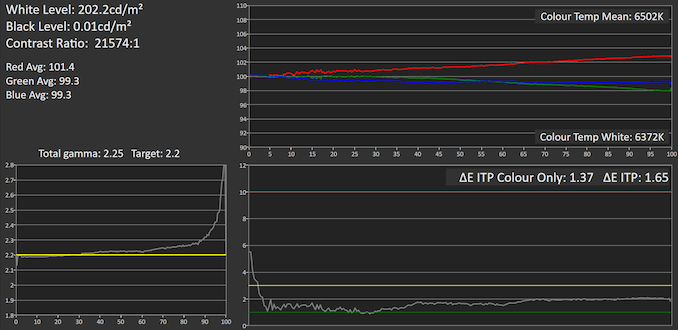
 Portrait Displays CalMAN
Portrait Displays CalMAN
iPhone 12 Pro
We start off the detailed measurements with the greyscale performance of the iPhone 12 Pro. Generally speaking, there’s very little to criticise the device here as there’s generally an excellent performance. Apple still showcases higher gamma at higher level colours, but that’s only a minor imperfection.
The white balance for whites actually is a tad warmer than it should be with some clearly higher-than-average levels of red. Although the total average white balance over all levels lands in at an excellent 6502K, actual whites land in at 6372K. It’s not an issue, but a little less perfect than we had come to expect from iPhones.
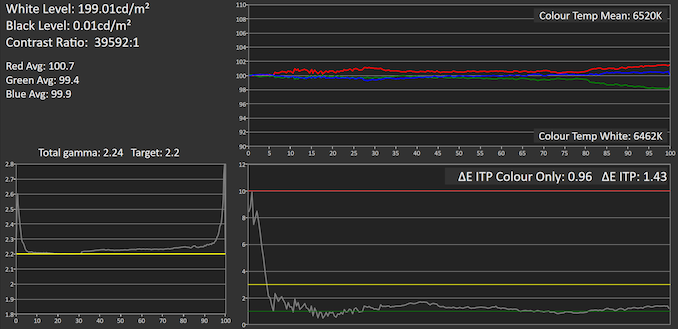
 Portrait Displays CalMAN
Portrait Displays CalMAN
iPhone 12
The iPhone 12 seems to showcase a different calibration than the 12 Pro, further evidence of the two different panels employed on the two models. The 12 seems to have slightly better gamma behaviour on the higher levels, but in exchange showcases worse off gamma at the lower levels, clipping lower level colours to black earlier than on the 12 Pro, which had near perfect behaviour here.
Oddly enough, colour temperature on the 12 behaved better than our 12 Pro sample. Average colour temperature landed in at 6520K while white landed in at 6462K, with less dominant reds than on the other phone.
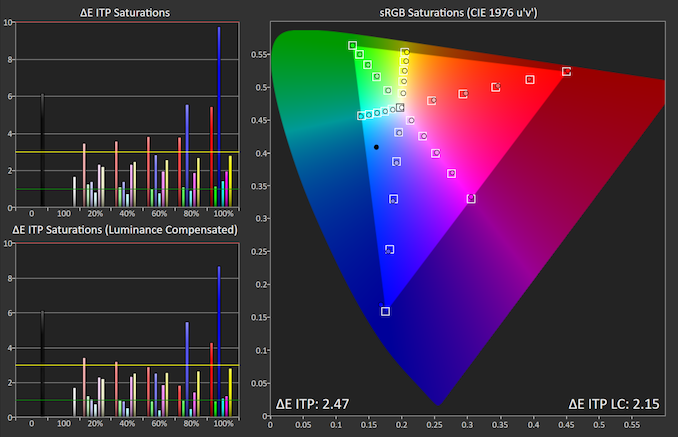 Portrait Displays CalMAN
Portrait Displays CalMAN
iPhone 12 Pro
sRGB colour saturations on the iPhone 12 Pro are quite excellent, with the biggest error margin happening at maximum saturation blues and magentas, with also a slightly oversaturated red. Below maximum intensity, the colours are all showcasing dEITP errors below 3 which is the just perceivable threshold for the average eye.
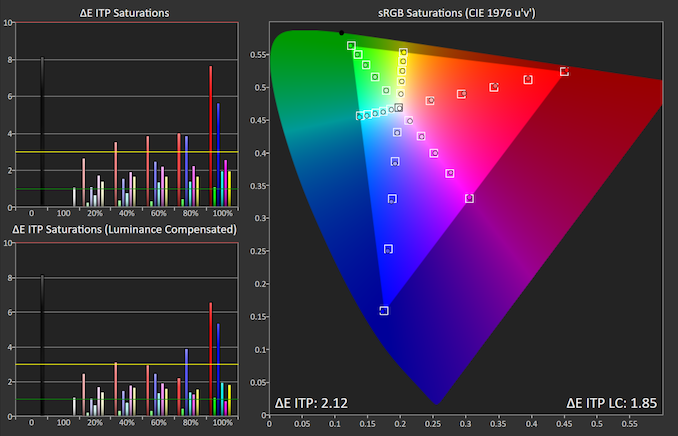 Portrait Displays CalMAN
Portrait Displays CalMAN
iPhone 12
The iPhone 12 has slightly better results, with the blue and magenta error being less pronounced on this phone. Generally it looks that our sample here is again performing a little better than our 12 Pro sample.

 Portrait Displays CalMAN
Portrait Displays CalMAN
iPhone 12 Pro
In our GMB chart with common colours such as skin tones, the iPhone 12 Pro behaves admirably. Given the phone’s inaccuracies seemed to be more prevalent in higher saturations in the blue and red spectrum, and this test doesn’t contain patches in that region of the gamut, it means that the remaining test colours perform extremely well.
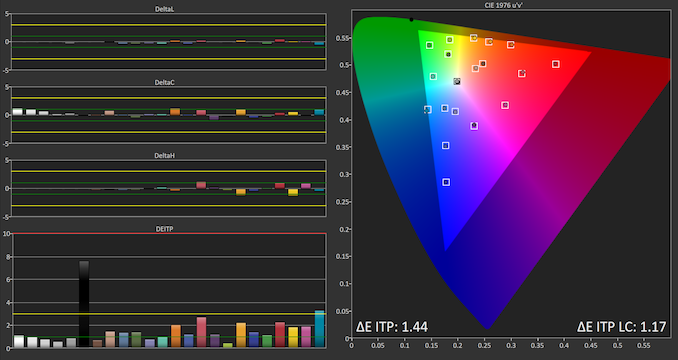
 Portrait Displays CalMAN
Portrait Displays CalMAN
iPhone 12
The iPhone 12 generally seems to beat the iPhone 12 Pro in terms of accuracy, again showcasing better results and an outstandingly good overall error result of dEITP of 1.44.
Apple Typical Best Displays
Overall, the new iPhone 12 series continues Apple’s tradition of having amongst the best calibrated displays on the market. The 12 Pro seems to just shy away from the usual Apple perfection, but the results are still outstandingly good and beyond that of any other device.
I think what’s most important for this generation of devices is the fact that the iPhone 12 now features a higher resolution OLED screen. It can’t be understated how much of an upgrade this is compared to the “Retina” grade LCD panel of the iPhone 11. Personally, this makes the iPhone 12 an actual consideration whereas I wouldn’t have been satisfied with using the iPhone 11’s LCD. It also vastly diminishes the feature gap to the Pro models – I don’t consider the brightness advantage of the 12 Pro to be all that significant, although again the Pro model does showcase better viewing angles and a more pronounced “sticker feel”.










101 Comments
View All Comments
mrvco - Monday, November 30, 2020 - link
It was a good run since the OG iPhone launched, but I seem to have lost all interest in replacing smart phones. I've been using an XS Max (~work phone) and an LG V40 (~personal phone) for two years now and I'm still perfectly satisfied with both devices. They both do what I ask of them with little fuss and there just haven't been any new features or phones that have generated more than a passing interest for me.Bob Todd - Monday, November 30, 2020 - link
As someone who would sometimes change phones more than once a year, I've been in a similar place. We are getting to the point of "good enough" performance. Faster is always better, but high end (and even midrange) SOCs are pretty good these days. My 2 year old phone has 8GB of RAM, 256GB of storage, and a nice large display.I do think this generation of iPhones is interesting for a few reasons though. The Mini doesn't even have a good analogue in the Android world, and I'm excited that premium smaller form factor phones are a thing again.
FunBunny2 - Monday, November 30, 2020 - link
"The Mini doesn't even have a good analogue in the Android world, and I'm excited that premium smaller form factor phones are a thing again."it depends on use case. for those who use a smartphone mostly as a phone, then these Godzilla handsets are contraindicated. OTOH, if the use case is mostly watching video on the run, then the Max and similar make the most sense. Steve clearly intended the former, Mr. Market gave him a full body enema by telling him to shove those teeny, tiny thingees.
KPOM - Monday, November 30, 2020 - link
My mother and sister both opted for the 12 mini since they got tired of big phones. I’m sure they aren’t alone.GC2:CS - Monday, November 30, 2020 - link
Well is there any reason why LPDDR5 was not used over the entire lineup (including M1) ? Is there some hidden compromise with LPDDR5 ?So if CPU is improved quite a bit in regards to efficiency, why the GPU lacks an update ? Is it possible that newer node benefits the CPU more than GPU ?
I heard about new Pro Oleds having better viewing angles. This is something i would greatly appreciate. 11´s Pro do have quite big shifts in white - at screen edges it has greenish, bluish cast. Can somebody describe it a but more ?
I think this generation could be better. But 5G is quite monumental increse in RF complexity and imagining they did it with custom antena designs and thinner designs is quite remarkable.
For exemple three mmWave antenas were discoverd so far. One on the side next to the battery, one behind the motherboard and one under the notch on the front.
But on the other hand 5G sucked up all the effort for other upgrades like better bigger cameras, batteries, 120 Hz and so on.
I refuse to believe that the next one is iPhone 13. That is just so unlucky...
michael2k - Monday, November 30, 2020 - link
I think you answered your own question. The focus on 5G took resources away from lpddr5.mmm200 - Monday, November 30, 2020 - link
I had both X and Xs Max, wife has 11 Pro.I could tell you how good the new 12 Pro Max display is.
It is better than Apple MBP16 in both color and brightness stability! 2 weeks in I'm amazed still how good the Pro display is!
Don't like the oversaturated images made indoor. Just too much vibrance and saturation. Looks unnatural.
2.5x telephoto is great outdoors in sunny weather.
HDR video capture is mindblowing! Using 1080p30 and 1080p60 - looks great on LG OLED!
name99 - Monday, November 30, 2020 - link
It's quite possible that world LPDD5 production capacity was not yet large enough?My GUESS is that the memory controller can handle LPDD5, and the M1X machines will ship with it (and those will be in low enough volume that it's not an issue).
I was surprised that the M1 Macs did not, but presumably Apple concluded it made no engineering sense -- they are clearly fast enough as is, so why not hold something in reserve to make the M1X machines look even better when they ship?
vFunct - Monday, November 30, 2020 - link
Why do you do camera tests without a SINGLE shot of a human being? You know, because how everyone uses phone cameras to take pictures of people at parties and other social events?Are you unable to find anyone willing to have photos taken?
michael2k - Monday, November 30, 2020 - link
Taking pictures of people aren't actually important for the test scenarios:Daylight evaluation is measuring the sensor and software in their ability to balance contrast, dynamic range, shadows, details, and color (and of course there were some people in those pictures)
Low light evaluation is evaluating how well the software can enhance the image without sacrificing color information, creating unusual color casts, capturing details, and balancing the light and darker portions of the pictures.
What you seem to be asking for is a review of https://www.anandtech.com/show/14892/the-apple-iph...">Portrait Mode? The 2018 https://www.anandtech.com/show/13392/the-iphone-xs...">Portrait Mode review was similarly brief (both less than 5 paragraphs!)